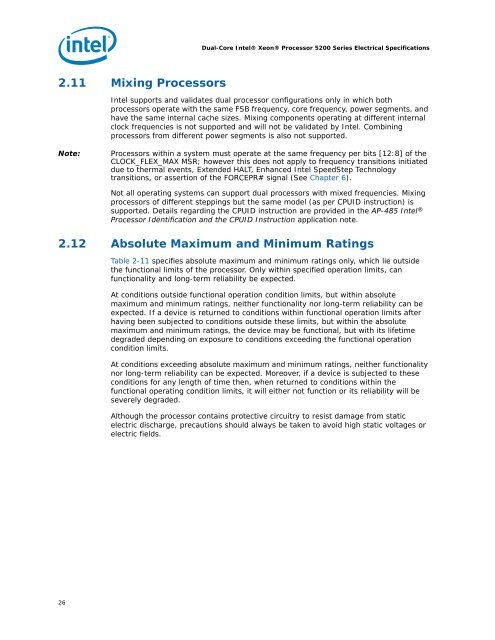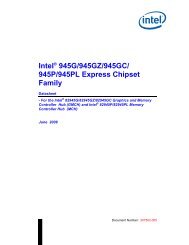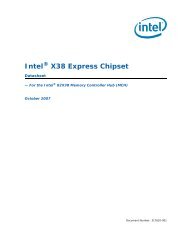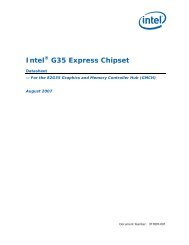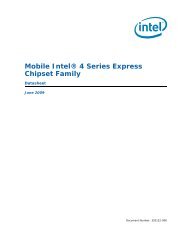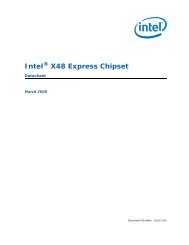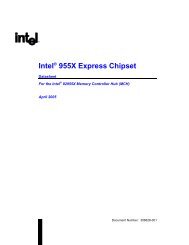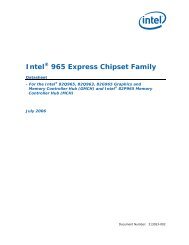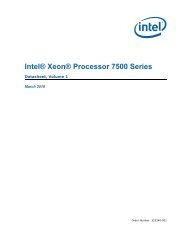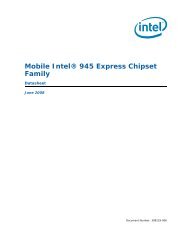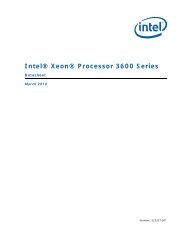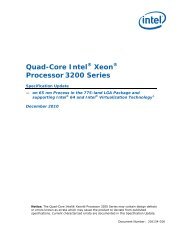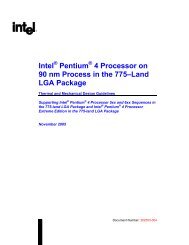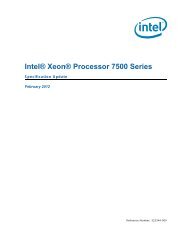Dual-Core Intel® Xeon® Processor 5200 Series
Dual-Core Intel® Xeon® Processor 5200 Series
Dual-Core Intel® Xeon® Processor 5200 Series
You also want an ePaper? Increase the reach of your titles
YUMPU automatically turns print PDFs into web optimized ePapers that Google loves.
2.11 Mixing <strong>Processor</strong>s<br />
26<br />
<strong>Dual</strong>-<strong>Core</strong> <strong>Intel®</strong> <strong>Xeon®</strong> <strong>Processor</strong> <strong>5200</strong> <strong>Series</strong> Electrical Specifications<br />
Intel supports and validates dual processor configurations only in which both<br />
processors operate with the same FSB frequency, core frequency, power segments, and<br />
have the same internal cache sizes. Mixing components operating at different internal<br />
clock frequencies is not supported and will not be validated by Intel. Combining<br />
processors from different power segments is also not supported.<br />
Note: <strong>Processor</strong>s within a system must operate at the same frequency per bits [12:8] of the<br />
CLOCK_FLEX_MAX MSR; however this does not apply to frequency transitions initiated<br />
due to thermal events, Extended HALT, Enhanced Intel SpeedStep Technology<br />
transitions, or assertion of the FORCEPR# signal (See Chapter 6).<br />
Not all operating systems can support dual processors with mixed frequencies. Mixing<br />
processors of different steppings but the same model (as per CPUID instruction) is<br />
supported. Details regarding the CPUID instruction are provided in the AP-485 Intel ®<br />
<strong>Processor</strong> Identification and the CPUID Instruction application note.<br />
2.12 Absolute Maximum and Minimum Ratings<br />
Table 2-11 specifies absolute maximum and minimum ratings only, which lie outside<br />
the functional limits of the processor. Only within specified operation limits, can<br />
functionality and long-term reliability be expected.<br />
At conditions outside functional operation condition limits, but within absolute<br />
maximum and minimum ratings, neither functionality nor long-term reliability can be<br />
expected. If a device is returned to conditions within functional operation limits after<br />
having been subjected to conditions outside these limits, but within the absolute<br />
maximum and minimum ratings, the device may be functional, but with its lifetime<br />
degraded depending on exposure to conditions exceeding the functional operation<br />
condition limits.<br />
At conditions exceeding absolute maximum and minimum ratings, neither functionality<br />
nor long-term reliability can be expected. Moreover, if a device is subjected to these<br />
conditions for any length of time then, when returned to conditions within the<br />
functional operating condition limits, it will either not function or its reliability will be<br />
severely degraded.<br />
Although the processor contains protective circuitry to resist damage from static<br />
electric discharge, precautions should always be taken to avoid high static voltages or<br />
electric fields.


